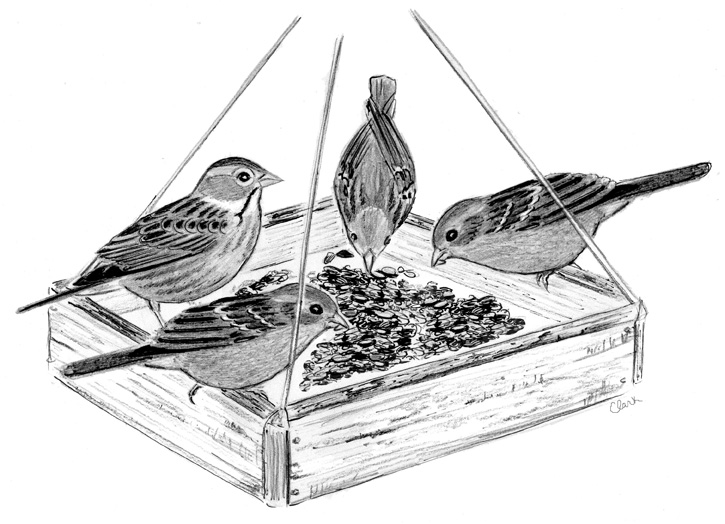
A surprise Dickcissel:
Last week, Casey was helping me unload a pallet of birdseed at work, when an odd bird caught my eye. I reached for the “emergency binoculars” we keep by the back door and zoomed in. “I think I see a Dickcissel,” I said, as I passed Casey the binoculars. And sure enough, there, in the middle of our gross back parking lot, feeding with a zillion House Sparrows, was a Dickcissel. I thought this would make a good column, until I discovered that I had already written about Dickcissels back in 2009. So, instead of writing a new column, I’m simply going to reuse the old one, complete with a joke I made about former Attorney General John Ashcroft. Although it was so long ago even I don’t get the joke now.
Dear Bird Folks,
Please find the attached photo. In the center of all those sparrows eating on our tray feeder is a bird with bits of yellow on its breast. We are pretty sure it’s a Dickcissel and we’ve never seen one in our yard before. Is it rare? What else can you tell us about it? – Beth and Terry, Chatham, MA
Oh no, Beth and Terry,
Not another bird with a suggestive name. It seems October has become the snicker bird month. We just had a question about titmice and now it’s Dickcissels. What’s next, a question about Blue-footed Boobies? I can see the newspaper editors frantically flipping through bird books wondering if Dickcissels are real birds or if they are being punked. It’s a good thing you didn’t ask this question back when stodgy old John Ashcroft was our Attorney General or you might be getting your answer wrapped in a blue curtain. (I think that might have been funny in 2009.) Yes, Dickcissels are real birds (the copyeditors can relax). In fact, they are small, sparrow-ish looking birds. The male Dickcissel is mostly brown with a black bib and yellow on his chest. The young and females have little or no bib and just splotches of yellow, looking like a cross between a sparrow and a guy who got in a fight with mustard.
I can understand why you aren’t familiar with Dickcissels, because they are infrequent visitors to New England. They typically breed near farms and grasslands in the Midwest. But this wasn’t always the case. I don’t know how old you two are but if you were around here during the time of the U.S. Civil War, you would have seen Dickcissels. They were fairly common birds in the eastern half of the U.S. during the 1800s, but then they all moved west. No one is sure why they moved, but the growing number of farms in the Great Plains was the likely cause. If you asked me, however, I’d blame cats. I have no evidence to back this up, but I just like to blame cats for everything.
The rather odd name of this bird has to do with the male’s song. To some ears it apparently sounds like it is singing “dick, dick, sissel, sissel.” Yeah, I guess. But there are few other more peculiar things about this bird than just its name. For one thing, no one really knows what family Dickcissels belong to. You and me might think they look and act like sparrows, but they aren’t sparrows. That would be too easy. At one time Dickcissels were thought to be blackbirds, even though they don’t look like blackbirds and they aren’t black. Recently researchers have included them with a family of birds that also includes cardinals. I’m sure the Dickcissels are thrilled with this new classification upgrade. Blackbirds and sparrows are fine birds, but the world seems to be fixated on cardinals. Cardinals are the avian equivalent to the Royal Family…only without all the scandal.
Speaking of scandal, it turns out the male Dickcissel is quite the player. When he arrives on the breeding grounds, he quickly stakes out a territory by singing and strutting his stuff. He is convinced that his fabulous singing, combined with his super-hot bod will attract lots of ladies. Nope. Not even close. Females really want a male that has acquired the best territory for nesting. Having a good voice is fine but these females are all about prime real estate. After a brief courtship the Dickcissel couple will mate and then get down to the business of raising a family. Well, the female will get down to it, not the male. He immediately goes back to singing and looking for more females. If another female stops by, he’ll mate with her, too. After that there’s more singing and perhaps more mating. It’s a highly successful procreation behavior, but I doubt John Ashcroft would approve.
Usually, Dickcissels head to Central and South America after the breeding season, but a few remain in North America and are liable to turn up anywhere. These stragglers often come to backyard feeders in the company of House Sparrows. Both birds can look confusingly similar in the fall, so it was very observant of you to notice one was different. I’ll bet you also had your emergency binoculars handy. Emergency binoculars are one of the more important things in life. Thanks for the question and photo, Beth and Terry. I was glad to answer your question about Dickcissels, just as I was happy to write about titmice last week. But I’m telling you right now, if next week’s question is about boobies, I’m forwarding it to the ghost of Benny Hill.